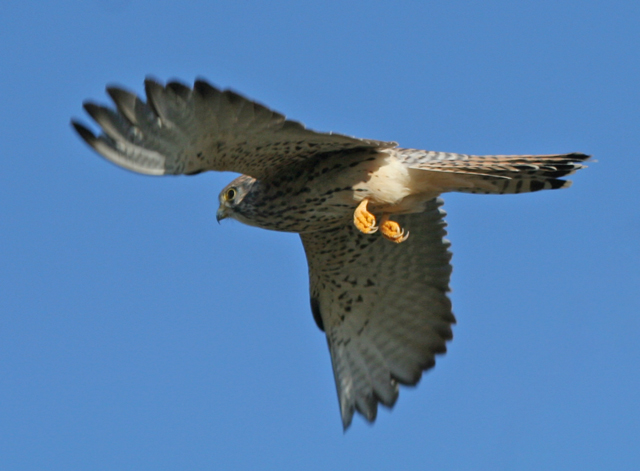Monday, 10 August 2015
| Lesser kestrel | |
|---|---|
 | |
| Male (right) and females | |
| Scientific classification | |
| Kingdom: | Animalia |
| Phylum: | Chordata |
| Class: | Aves |
| Order: | Falconiformes |
| Family: | Falconidae |
| Genus: | Falco |
| Species: | F. naumanni |
| Binomial name | |
| Falco naumanni Fleischer, 1818 | |
 | |
| Range of F. naumanni Breeding range Year-round range Wintering range | |
Description
 It is alittle bird of prey, 27–33 cm (11–13 in) long with a 63–72 cm (25–28 in) length. it's abundantly just like the larger common kestrel however has proportionately shorter wings and tail. It shares a brown back and barred gray underparts with the larger species. The male incorporates a gray head and tail like male common kestrels, however lacks the dark recognizing on the rear, the black malar stripe, and has gray patches within the wings.
It is alittle bird of prey, 27–33 cm (11–13 in) long with a 63–72 cm (25–28 in) length. it's abundantly just like the larger common kestrel however has proportionately shorter wings and tail. It shares a brown back and barred gray underparts with the larger species. The male incorporates a gray head and tail like male common kestrels, however lacks the dark recognizing on the rear, the black malar stripe, and has gray patches within the wings.The female and young birds square measure slightly paler than their relative, however square measure therefore similar that decision and structure square measure higher guides than plume. the decision may be a diagnostic harsh chay-chay-chay, in contrast to the common kestrel's kee-kee-kee. Neither sex has dark talons as is common in falcons; those of this species square measure a peculiar whitish-horn color. This, however, is merely conspicuous once birds square measure seen at terribly shut vary, e.g. in captivity
 Despite its outward similarity, this species seems to not be closely associated with the common kestrel. In fact, mtDNA hemoprotein b sequence analysis places it at a basal position with regards to the opposite "true" kestrels (i.e., excluding the sparrow hawk and doubtless the gray African kestrels too). Its divergence is tentatively placed to round the Miocene-Pliocene boundary (Messinian to Zanclean, or regarding 7–3.5 mya). The morphological similarity with the common kestrel is most puzzling, however still it seems to betray the current species' actual relationships: the dearth of a malar stripe appears ancestral for kestrels, and therefore the gray wing color unites the lesser kestrel with most alternative Falco species, however not the opposite true kestrels.
Despite its outward similarity, this species seems to not be closely associated with the common kestrel. In fact, mtDNA hemoprotein b sequence analysis places it at a basal position with regards to the opposite "true" kestrels (i.e., excluding the sparrow hawk and doubtless the gray African kestrels too). Its divergence is tentatively placed to round the Miocene-Pliocene boundary (Messinian to Zanclean, or regarding 7–3.5 mya). The morphological similarity with the common kestrel is most puzzling, however still it seems to betray the current species' actual relationships: the dearth of a malar stripe appears ancestral for kestrels, and therefore the gray wing color unites the lesser kestrel with most alternative Falco species, however not the opposite true kestrels.The lesser kestrel is, because the name implies, a smaller and a lot of delicate bird than the common kestrel, and it's entirely sympatric in its breeding vary with it; they vie to a restricted extent. Thus, the likelihood that there's some style of reconciling advantage to the similar coloration deserves study. Considering that the lesser kestrel would if truth be told have a bonus if some would-be predators confused it with the larger species and consequently avoided it, it'd be a case of Müllerian mimicry.
The lesser kestrel chow insects, however additionally tiny birds, reptiles and rodents (especially mice), that ar typically taken on the bottom. It nests colonially on buildings, cliffs, or in tree holes, giving birth up to 3–6 eggs. No nest structure is constructed, that is typical for falcons. On their wintering grounds in geographical area, lesser kestrels favor a "latitude belt" through African nation wherever locusts and grasshoppers ar plentiful. Surveys of lesser kestrels wintering in Gregorian calendar month 2007 by the Ligue pour la Protection des Oiseaux unconcealed them roosting communally. A roost in African nation discovered throughout one amongst the surveys command twenty eight,600 birds, along with sixteen,000 caudated kites Chelictinia riocourii.
It is widespread and plentiful on a world scale, and also the IUCN have classed it as Least Concern. excluding attainable home ground destruction, it seems that indiscriminate use of pesticides features a robust result on this species as a result of its myrmecophagous habits.


0 comments:
Post a Comment